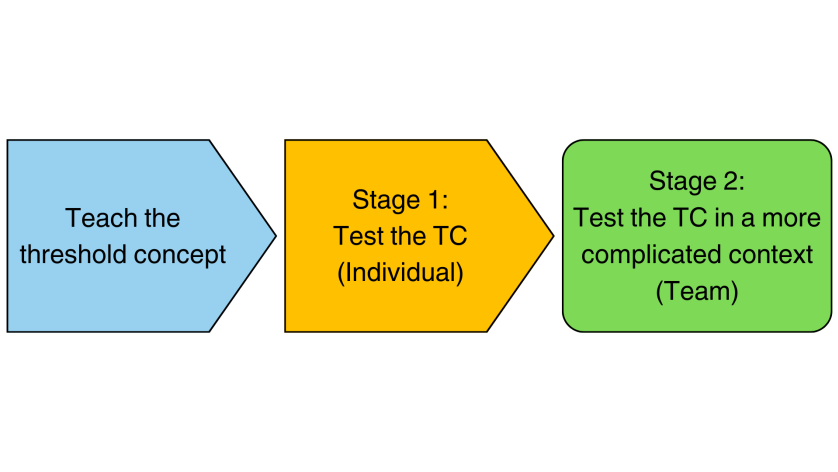
How data makes student–supervisor matching meaningful
Rethinking student–supervisor matching for educational gains
- Home
- / Insights
- / Knowledge sharing
- / Experimenting with task-based team learning
Experimenting with task-based team learning

Authors

Dr Eva Pocher CMBE
Lecturer in Economics, University of Aberdeen Business School

Dr Lovleen Kushwah CMBE
Senior Lecturer, Adam Smith Business School, University of Glasgow
Enhancing student engagement using collaborative work in a framework of taught topics is nothing new. Team-based learning facilitates conceptual understanding and helps students develop communication skills (Gosser & Gosser, 2001). It has been incorporated in our teaching practice to overcome a challenge in our undergraduate Economics courses.
Course evaluations of our heavily theory focused courses – held online due to the pandemic – repeatedly indicated that students wanted to get a more detailed insight into different real-life applications of the theories taught in addition to the many real-world examples we were providing during recorded lectures and online seminars. We gathered oral feedback from students, learning that some students were struggling to relate theoretical knowledge and abstract ideas to real-world occurrences from our lectures and seminars. Furthermore, our teaching practice was partly didactic in nature, having students learn concepts passively via our recorded lecture videos. Discussions in weekly online seminars were very difficult to initiate and were often replaced by the lecturer introducing real-life examples in a monologue. We realised that such teaching methods contradicts the idea that teachers must spend time helping students to learn ways to implement important concepts rather than learning them passively (Michaelsen, 1992).
Having returned to campus after years of online teaching during the pandemic, we decided to modify some of our existing teaching methods in a pilot, using the in-person teaching by adding team-based learning concepts, not only to improve the subject knowledge, but also to help students struggling to engage with their peers. Interactions with classmates are essential for improving social skills, communication skills, handling critics and praise, as well as learning from each other e.g. about the taught subject knowledge. With our modified approach, we thereby created a new teaching strategy, whose effectiveness we would evaluate by collecting student responses in a survey.
This new teaching strategy consisted of 2 parts: the teaching of the theory by the lecturer (teacher-centred teaching approach as by Weimer (2002) and Angelo and Cross (1993)); and the team-based learning concept.
The team-based learning approach consists of three activities that will lead to an improved learning outcome, the building of learning communities through knowledge sharing and peer feedback, thus making the most of an international classroom. It should be noted that we will remain passively involved during these activities and only clarify students’ questions.
Icebreaker activity
We begin the course with an icebreaker session. This allows students to get acquainted with each other and participate in short discussions about themselves in an academic context. We take on the initiative to form the final groups to alleviate anxiety (Crose, 2011) and accommodate diversity (Arkoudis, 2006; Jones, 2010). A week before the first lecture, we inform students about the upcoming group activity and ask them to find out a few things about their country. A teacher-led icebreaking conversation (Collins, 2010) can help with the exchange of information (Zwaagstra, 1997), build a community (Macheski et al., 2008), support internationalisation (Crose, 2011), and establish focus. Listening to their peers can help students to learn new things as these simple and personalised questions facilitate the exchange of knowledge. Typical icebreaker questions could be:
‘What is the name of the monetary institution in your country?’
‘Explain recent economic trends and events in your country and highlight why these might have occurred?’
Teaching and reinforcing Threshold Concepts
Threshold concepts (TCs) are defined as ideas that help students to open themselves up to new ways of thinking (The Economics Network). If students do not understand these concepts, then they may find themselves in a state of liminality, or a ‘stuck place’ (Land et al., 2010), which is unstable, and they might oscillate between old and new understandings. (Cousin, 2006).
We teach some of the TCs, e.g., ‘competitive advantage’ in the context of International Economics, and then use a two-stage formative assessment (Zipp, 2007; Levy et al., 2018) to forge learning. In the first stage, learners test their understanding of TCs individually using a multiple-choice test. In the second stage, students form groups and are presented with a practical and complicated exercise that uses two or more TCs and is to be solved cooperatively.

Re-engaging team activities
After covering all TCs, we use a research-tutored collaborative student-led approach to teach some of the difficult topics and re-invigorate students’ enthusiasm. Since students were involved in the previous icebreaker activity, it is easy to implement a team-based discussion (Kingston & Forland, 2008).
All group discussion questions are provided by us to help peak students’ interest, encourage students to think about the economics behind current systems and help them to relate to the course content. For example, while reviewing theories and academic papers, we ask students to reflect on their personal experiences in their own country of origin. Questions may include:
‘Has there been any major crisis (trade war, currency, or debt) in your country in recent times? Or historically?’
How were you affected and which policy would you have recommended to overcome this crisis?
Findings and Conclusion
We trialled our new teaching method in face-to-face lectures when teaching returned to on-campus delivery. Here, group activities were initially welcomed by students. However, during these group activities, we observed that several students were still very hesitate to speak in groups and participate in formative assessments. When talking to students after class, some were very positive, starting that the two-stage activity was helpful in emphasising the importance of TCs and relating them to the real world. This activity also gave them an opportunity to discuss and address practical issues while learning. Thus, for some of our students, the team-based activities encouraged communication between peers, provoked peer feedback during discussions and improved the understanding of the taught theories. Additionally, these activities facilitated an improved employability and lowered prejudices due to increasing the political and economic knowledge of different countries. Other students, however, expressed issues with language barriers and communication anxiety.
The survey responses at the end of the course showed that many students – approximately half the class – liked the task-based learning, confirming what we had learned in our after-class talks with students. However, several students preferred to remain anonymous and preferred classroom level discussions. One of the main reasons listed was due to the language barrier, which would make them feel uncomfortable. This finding is in alignment with the common experience of educators after Covid-19, which impacted skills required for social interactions (Viegas et al., 2023). Thus, it seems that students prefer a teaching approach that involved less interaction with their peers. We believe that students will adjust to peer interactions in the years to come. As such, we will continue providing opportunities for team-learning activities in our courses.
In summary, we recommend attempting team-based learning, allowing students to integrate and influence their immediate social environments (Gabb, 2006). Deep learning will also be achieved as students engage with course material and connect it to the real world (DeLotell, 2010). Furthermore, it can facilitate the transfer of knowledge and skills between group members (Pfaff and Huddelston, 2003).
